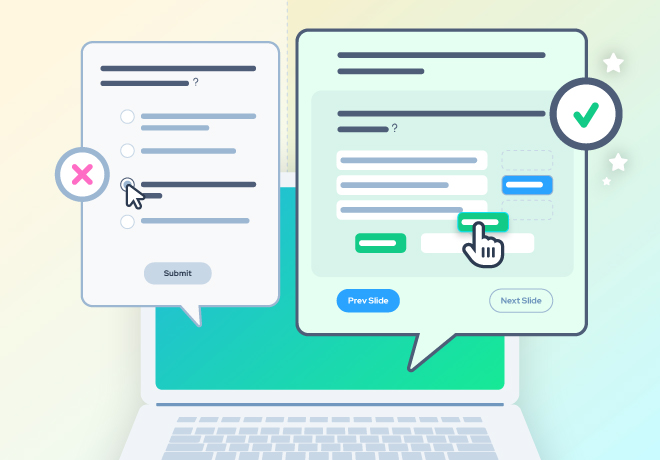
How to know when you should move your offline training program online

Related articles
Get valuable eLearning insights to your inbox.
Listen to Neovation’s Demystifying eLearning podcast generated with NotebookLM!
Listen to our podcast on your favorite platform!
Is this the question that keeps you up at night?
The answer means change, and change is scary. You want to make sure you’re making the right decision. You make lists of pros and cons. You read the tea leaves. You look for signs everywhere. You do a cost/benefit analysis to measure expense versus ROI. You toss a coin – heads is this quarter, tails is next quarter. You ask your trusted advisors at other companies what they have done in similar situations. And at some point, it becomes easier to decide not to decide, and you pick the known quantity, the safe, the familiar, the status quo – and you may choose to do nothing when you absolutely need to do – something – differently.
Embrace the change. If you are asking, “How do I know when I should move my training online?” the answer is “As soon as you can.” You’ve already decided that it needs to happen (you’re asking when not why); you just may be stuck in a version of analysis paralysis because you’re afraid the work may not be worth it.
So let me offer you a cup of nice warm cocoa and a fuzzy blanket, and soothe your fears. What? Sorry! Of course, you're not afraid – not of changing the way your company delivers all of its team training. What’s there to be afraid of? That’s what I’m here to tell you – nothing to be afraid of – seriously.
In this article, we’ll cover 6 top indicators that will help you decide, with certainty, that the time for moving your training online is now:
- You have remote employees
- You’re in a compliance-based or regulated industry
- You have large cohorts to train
- You need to improve your training results
- You need to prove the ROI of the training
- You want to build a training plan for the future
Soon, you’ll be sleeping straight through the night, safe and secure in the knowledge that the right training content is being delivered to the right learners at the right time.
It’s time to move your training program online when...
You have remote employees
These days, who doesn’t? Or perhaps, more correctly, who didn’t during the Pandemic of 2020-2022? Corporate structures underwent a seismic shift, with many companies choosing to allow their staff to remain either fully or partially remote. However, it’s important to remember that many companies had distributed teams long before the Pandemic. Head Offices were separated from manufacturing and distribution facilities. Franchises had units across multiple cities, each with managers and front-line staff. Companies access a global talent pool to deliver world-class products and services. The concept of remote employees is not new.
Using an online training program allows you to train all employees equitably. No one is denied access to training because of their availability or geographic location. As long as your team member has an internet connection and a web-worthy device (desktop, laptop, tablet, or cell phone), they can take all their needed training online. From employee onboarding to everboarding to compliance training, upskilling, and reskilling – everyone can get the training they need, available when they can access it, across time zones.
You are in a compliance-based or regulated industry
Government regulations are becoming increasingly stringent and increasingly concerned that workers are measured for their knowledge retention, as opposed to their mere interaction with training materials. Similarly, workers who must maintain a compliance-driven certification don’t want to be forced to stop their work for a few days per year, inevitably at the worst time possible, to sit through the same old compliance course they’ve taken every year since they started – just to check a box on their paperwork that says they have “taken the training” – again. Isn’t the point of compliance training retention, not attendance?

Online training allows you to do compliance training differently. You can break your compliance training materials into bite-sized pieces and deliver daily refresher training using microlearning. You can also test for knowledge retention more frequently and use an adaptive training platform to deliver training specific to each individual learner’s unique knowledge gaps. You can measure continued retention, which can then be paired with relevant Key Performance Indicators (KPIs) to demonstrate the effectiveness of your online training. You’ll have proof positive at Audit time, when the regulators dig into your training program, that your employees are not only well-trained but retaining knowledge, and here’s the proof – measured in fewer accidents, improved quality control metrics, increased productivity, and lower employee turnover – for example.
You have large cohorts to train
The more people you have to train, the more challenges you face. Do you have a seasonal hiring surge to onboard? Do you need to upskill or reskill a significant number of your team to a new operating procedure or new technology, or new policy? Have you identified common knowledge gaps in a certain job role or level of responsibility, and you need to ensure everyone is equally well-trained within a finite timespan? These are just a few of the “Large Cohort” scenarios that can be addressed with online training. And this leads nicely to my next point.
You need to improve your training results
There are three key areas that online training can improve – employee satisfaction, employee engagement, and knowledge retention. Let’s look at all three of these.
Employee Satisfaction
Here’s a bit from an article I wrote on employee onboarding,
“People WANT to work and succeed. They need to feel welcome, feel integral and continually improve their competence in order for them to do their best work – whether it’s making sandwiches at a quick service restaurant or assembling a vehicle on an assembly line. They want to be part of the whole – and feel part of the mission – that their work produces something of value. No one wants to be a cog in a machine. Linkedin Learning’s 2022 report tells us that employees who feel their skills are not being put to good use are 10X more likely to look for a new opportunity. If all work is honorable and worthy of compensation, then setting a tone that says “you are a valued asset and part of the whole” needs to start as early as day one.

Employee Engagement
A happy employee is most often an engaged employee. You can build on that engagement by implementing a “learner-first” training approach, one that focuses on the learner experience to ensure that your team will enjoy taking their training. If we’re in business, we know that all communication should be receiver focused, right? Same thing with training – everything we do when we offer training should mean putting the learner experience first, followed by our ability to analyze those results (but that’s a different article).

Knowledge Retention
Finally, let’s talk about knowledge retention. Your move to online training should begin with a training audit, including a knowledge check, which is a series of questions to determine what knowledge gaps may exist in your existing training material and for your learners. This fact-finding mission then helps you reshape your training as you build out your online courses and performance supports. Your LMS or microlearning platform will allow you to measure your learner’s growing retention with empirical statistics – so much more accurate than smile sheets that measure supposed course enjoyment. You can use your online tools to deliver quizzes, tests, flashcards, and exams to ensure learners are absorbing and retaining knowledge. If you are using a microlearning platform, you can deliver daily training that lasts only a few minutes a day. If you really want to get into the science of learning retention, take a look at the whitepaper we wrote specifically about microlearning, “The Cognitive Science Behind OttoLearn” – however, it contains a great overview of the science of eLearning, written for those of us who aren’t scientists. But I digress.
You need to prove the ROI of training
When your industry is facing economic challenges, are the first two departments that experience funding cuts often Marketing and Learning & Development? You aren’t alone. The value of training is often felt to be intangible because “people know what they need to do” to do their jobs, right? Wrong. They may know “what to do,” but they can always learn to do it better, add new skills to do more, or prepare for the next step up the chain of command. You may want them to work more safely, produce more widgets, earn more sales, reduce existing customer churn, enter a new market with confidence, launch a new product like they know what they’re talking about… so many reasons training helps both new and tenured workers do more, better work for your company. And they can’t do it if they don’t get ongoing training. But how do we prove it’s worth it?
I mentioned starting with a Training Audit. One of the first things you’ll be doing is ratifying your training strategy to match your corporate goals. If the purpose of your training program is to change behavior to meet those corporate goals better, then you can measure changes to the KPIs that matter – reduced safety violations, increased productivity, higher sales, less client churn – as the training has an impact over time on how people do their jobs.

It's all about measuring the proper outcomes – not how many courses a person takes during their tenure with their company, but how their behavior, productivity, job satisfaction, and other “outputs” have improved to meet your shared corporate goals.
To prove your training ROI, your online training delivery platform(s) will need to provide you with the right analytics that measures learner knowledge retention and engagement. You will also need access to financial information about all the costs incurred by your learning and development program. This may include highly confidential data, such as salaries, or you can agree with your leadership that you are accounting for “all costs except human capital” - as long as you are using consistently derived numbers for your ongoing analysis.
Here’s a post from one of our product’s blog archives that might help put training ROI into perspective. It’s called “What Trainers Can Learn from Marketers about ROI.” And check our learning hub for more posts on training analytics and ROI as we are always adding new content. Alternatively, continue your journey with a new topic that interests you from the selection available through our introduction to online training resources.
You want to build a training plan for the future
So, your company is now established and not going anywhere. Or maybe you’ve been around for a while and done things the same way since inception, or changes move forward at a glacial pace. We all can agree that technology will only advance and provide us more opportunities to do “what we do” more efficiently, effectively, and enjoyably than ever before. To remain competitive, to improve employee job satisfaction, to retain your customers and earn new ones – you need to use every progressive tool that technology can provide.
Moving your corporate training online only makes sense. If we sat down over that nice hot cup of cocoa, I’m sure we could brainstorm a hundred reasons, large and small, that would resonate with you and your company’s desire to be both profitable and tenured in the marketplace. For all the reasons I’ve discussed and more - don’t you think it's time to take the first steps you need to move your corporate training online? You’ll be glad you did.

With 15+ years of online marketing and online learning experience, Susan loves to share insights about where these two ROI-building practices can intersect and complement each other for your business or organization.
Become part of our L&D community
We publish a new learning hub article — full of useful, practical topics — weekly.
Not sure where where you want to start? Jump into one of our recently published articles and see where it takes you!








-svg.svg)
-svg.svg)
-svg.svg)
-svg.svg)